Myanmar Army
| Myanmar Army တပ်မတော်(ကြည်း) | |
|---|---|
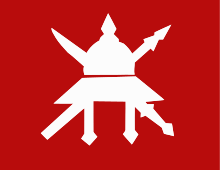 The Myanmar Army's flag | |
| Founded | 1945 |
| Country |
|
| Type | Ground army |
| Size | 406,000[1] |
| Part of |
|
| Nickname(s) | Tatmadaw |
| Anniversaries | 27 March 1945 |
| Commanders | |
| Commander-in-Chief | Vice Senior General Soe Win |
| Notable commanders |
Major General Aung San General Ne Win |
The Myanmar Army (Burmese: တပ်မတော်(ကြည်း), pronounced: [taʔmədɔ̀ tɕí]) is the largest branch of the Armed Forces (Tatmadaw) of Myanmar (Burma) and has the primary responsibility of conducting land-based military operations. The Myanmar Army maintains the second largest active force in Southeast Asia after the Vietnam People's Army.
The Myanmar Army had a troop strength of around 350,000 as of 2006.[2] The army has extensive combat experience in fighting insurgents in rough terrains, considering it has been conducting non-stop counter-insurgency operations against ethnic and political insurgents since its inception in 1948.
The force is headed by the Commander in Chief (Army) (ကာကွယ်ရေးဦးစီးချုပ်(ကြည်း)), currently Vice-Senior General Soe Win, concurrently Deputy Commander-in-Chief of the Defence Services, with Senior General Min Aung Hlaing as the Commander-in-Chief (တပ်မတော်ကာကွယ်ရေးဦးစီးချုပ်). The highest rank in the Myanmar Army is Senior General, equivalent to Field Marshal position in Western Armies and is currently held by Min Aung Hlaing after being promoted from Vice-Senior General.
In 2011, following transition from military junta government to civilian parliamentary government, the Myanmar Army enacted a military draft for all citizens, all males from the age 18 to 35 and all females age between 18 and 27 years of age can be drafted into military service for two years as enlisted personnel in time of national emergency. The ages for professionals are up to 45 for men and 35 for women for three years service as commissioned and non commissioned officers.
An official publication has revealed that almost one-quarter of Myanmar's new national budget will be allocated to defence. The Government Gazette reports that 1.8 trillion kyat (about $2 billion at free market rates of exchange), or 23.6 percent of the 2011 budget will go to defence.[3]
Brief history
Post Independence era

At the time of Myanmar's independence in 1948, the Tatmadaw was weak, small and disunited. Cracks appeared along the lines of ethnic background, political affiliation, organisational origin and different services. Its unity and operational efficiency was further weakened by the interference of civilians and politicians in military affairs, and the perception gap between the staff officers and field commanders. The most serious problem was the tension between ethnic Karen Officers, coming from the British Burma Army and Bamar officers, coming from the Patriotic Burmese Forces (PBF).[4]
In accordance with agreement reached at Kandy Conference in September 1945, the Tatmadaw was reorganised by incorporating the British Burma Army and the Patriotic Burmese Forces. The officer corps shared by ex-PBF officers and officers from British Burma Army and Army of Burma Reserve Organisation (ARBO). The British also decided to form what were known as "Class Battalions" based on ethnicity. There were a total of 15 rifle battalions at the time of independence and four of them were made up of former members of PBF. All influential positions within the War Office and commands were manned with non-former PBF Officers. All services including military engineers, supply and transport, ordnance and medical services, Navy and Air Force were all commanded by former Officers from ABRO and British Burma Army.[4]
| Battalion | Ethnic/Army Composition |
|---|---|
| No. 1 Burma Rifles | Bamar (Burma Military Police) |
| No. 2 Burma Rifles | Karen majority + Other Non-Bamar Nationalities (commanded by then Lieutenant Colonel Saw Chit Khin (karen officer from British Burma Army) |
| No. 3 Burma Rifles | Bamar / Former members of Patriotic Burmese Forces |
| No. 4 Burma Rifles | Bamar / Former members of Patriotic Burmese Force - Commanded by the then Lieutenant Colonel Ne Win |
| No. 5 Burma Rifles | Bamar / Former members of Patriotic Burmese Force |
| No. 6 Burma Rifles | Bamar / Former members of Patriotic Burmese Force |
| No. 1 Karen Rifles | Karen / Former members of British Burma Army and ABRO |
| No. 2 Karen Rifles | Karen / Former members of British Burma Army and ABRO |
| No. 3 Karen Rifles | Karen / Former members of British Burma Army and ABRO |
| No. 1 Kachin Rifles | Kachin / Former members of British Burma Army and ABRO |
| No. 2 Kachin Rifles | Kachin / Former members of British Burma Army and ABRO |
| No. 1 Chin Rifles | Chin / Former members of British Burma Army and ABRO |
| No. 2 Chin Rifles | Chin / Former members of British Burma Army and ABRO |
| No. 4 Burma Regiment | Gurkha |
| Chin Hill Battalion | Chin |
Formation and structure
The Army has always been by far the largest service in Myanmar and has always received the lion's share of the defence budget.[5][6] It has played the most prominent part in Myanmar's struggle against the 40 or more insurgent groups since 1948 and acquired a reputation as a tough and resourceful military force. In 1981, it was described as 'probably the best army in Southeast Asia, apart from Vietnam's'.[7] The judgement was echoed in 1983, when another observer noted that "Myanmar's infantry is generally rated as one of the toughest, most combat seasoned in Southeast Asia".[8] In 1985, a foreign journalist with the rare experience of seeing Burmese soldiers in action against ethnic insurgents and narco-armies was 'thoroughly impressed by their fighting skills, endurance and discipline'.[9] Other commentators throughout that time characterised the Myanmar Army as 'the toughest, most effective light infantry jungle force now operating in Southeast Asia'.[10] Even the Thai people, not known to praise the Burmese lightly, have described the Myanmar Army as 'skilled in the art of jungle warfare'.[11]
Organisation
Myanmar Army had reached some 370,000 active troops in all ranks in the year 2000. There were 337 infantry battalions, including 266 light infantry battalions. Although the Myanmar Army's organisational structure was based upon the regimental system, the basic manoeuvre and fighting unit is the battalion, known as Tat Yinn ((တပ်ရင်း)) in Burmese. This comprised a headquarters unit; five rifle companies Tat Khwe ((တပ်ခွဲ)) with three rifle platoons Tat Su ((တပ်စု)) each; an administration company with medical, transport, logistics and signals units; a heavy weapons company including mortar, machine gun and recoilless gun platoons. Each battalion is commanded a Lieutenant Colonel Du Ti Ya Bo Hmu Gyi or Du Bo Hmu Gyi with a Major (bo hmu) as 2IC (Second in Command), with a total establishment strength of 27 officers and 723 other ranks. Light infantry battalions in the Myanmar Army have much lower establishment strength of around 500; this often leads to these units being mistakenly identified by the observers and reporters as under strength infantry battalions.
With its significantly increased personnel numbers, weaponry and mobility, today's Tatmadaw Kyee (တပ်မတော်(ကြည်း)) is a formidable conventional defence force for the Union of Myanmar. Troops ready for combat duty have at least doubled since 1988. Logistics infrastructure and Artillery Fire Support has been greatly increased. Its newly acquired military might was apparent in the Tatmadaw's dry season operations against Karen National Union (KNU) strongholds in Manerplaw and Kawmura. Most of the casualties at these battles were the result of intense and heavy bombardment by the Tatmadaw Kyee. The Tatmadaw Kyee is now much larger than it was before 1988, it is more mobile and has greatly improved armour, artillery and air defence inventories. Its C3I (Command, Control, Communications, Computers and Intelligence) systems have been expanded and refined. It is developing larger and more integrated, self-sustained formations to better coordinated action by different combat arms. The army may still have relatively modest weaponry compared to its larger neighbours, but it is now in a much better position to deter external aggression and respond to such a threat should it ever arise, although child soldiers may not perform very well in combating with enemies.[12]
Expansion
The first army division to be formed after the 1988 military coup was the 11th Light Infantry Division (LID) in December 1988 with Colonel Win Myint as commander of the division. In March 1990, a new regional military command was opened in Monywa with Brigadier Kyaw Min as commander and named North-Western Regional Military Command. A year later 101st LID was formed in Pakokku with Colonel Saw Tun as commander. Two Regional Operations Commands (ROC) were formed in Myeik and Loikaw to facilitate command and control. They were commanded respectively by Brigadier Soe Tint and Brigadier Maung Kyi. March 1995 saw a dramatic expansion of the Tatmadaw as it established 11 Military Operations Commands (MOC)s in that month. MOC are similar to Mechanised Infantry Divisions in western armies, each with 10 regular infantry battalions (Chay Hlyin Tatyin), a headquarters, and organic support units including field artillery batteries. Then in 1996, two new RMC were opened, Coastal Region RMC was opened in Myeik with Brigadier Sit Maung as commander and Triangle Region RMC in Kengtung with Brigadier Thein Sein as commander. Their new ROCs were opened in Kalay, Bhamo and Mongsat. In late 1998, two new MOCs were opened in Bokepyin and Mongsat.[13]
The most significant expansion after the infantry in the army was in armour and artillery. Beginning in 1990, the Tatmadaw procured 18 T-69II Main Battle tanks and 48 T-63 amphibious light tanks from China. Further procurements were made, including several hundred Type 85 and Type 92 Armoured Personnel Carriers (APC). By the beginning of 1998, Tatmadaw had about 100+ T-69II Main battle tanks, a similar number of T-63 amphibious light tanks and several T-59D tanks. These tanks and armoured personnel carriers were distributed into five armoured infantry battalions and five tank battalions and formed the first Armoured Division of the Tatmadaw under the name of 71st Armoured Operations Command with its headquarters in Pyawbwe.
Chief of Staff and Commander in Chief of Myanmar Army (from 1945 onwards)
Up until 1990, Myanmar Armed Forces has Chief of Staff system and Myanmar Army was led by Vice Chief of Staff (Army). A new system was introduced in 1990 during Armed Forces reorganisation and all three branches of Armed Forces are now led by the Commander-in-Chief.[6]
| Serial | Rank and Name | Dates | Notes |
|---|---|---|---|
| BC5107 | Brigadier General Saw Kyar Doe | 4 January 1948 – 31 July 1948 | Karen Officer, then named "Deputy Chief of Army staff. Was replaced with Ne Win in August 1948. So Kya Doe moved to the post of Chief of Operation but forced to retire due to civil war with Karen |
| BC3502 | Brigadier General Ne Win | 1 August 1948 – 1 February 1949 | Member of Thirty Comrades, Became Chief of General Staff in February 1949. Later became President and Chairman of Burma Socialist Programme Party (BSPP) till July 1988 |
| BC5458 | Brigadier General Aung Gyi | 28 April 1959 – 7 February 1963 | Promoted from Colonel General Staff in April 1959 as Vice Chief Staff (Army) but resigned in February 1963 and was imprisoned few times. First Chairman of NLD but left after few months in December 1988. |
| BC3569 | Brigadier General San Yu | 9 February 1963 – 20 April 1972 | Later became Chief of Defence Staff in April 1972 // then Became Secretary of Council of State in March 1974 President |
| BC3651 | Brigadier General Thura Tin Oo | 20 April 1972 – 1 March 1974 | Succeeded San Yu as Chief of Defence Staff in 1974 but dismissed two years later and imprisoned for alleged holding of information in coup attempt next year, later founded NLD with Suu Kyi and Aung Gyi and became Vice-Chairman of National League for Democracy and Chairman when Aung Gyi left. House arrest for few times and became Vice Chairman of NLD again and later Patron of NLD |
| BC5332 | Brigadier General Thura Kyaw Htin | 2 March 1974 – 6 March 1976 | Later became Defence Minister and Deputy Prime Minister // Briefly became Joint General Secretary of BSPP in 1988 July- September |
| BC6133 | Lieutenant General Aye Ko | 2 April 1976 – 7 August 1981 | Later became BSPP General Secretary and then Vice President |
| BC5896 | Lieutenant General Tun Ye | 7 August 1981 – 21 July 1983 | Retired from Army in 1983 at age 60 and became Member of Council of State till 1988. Then became General Secretary and then Chairman of National Unity Party which was re-incarnation of BSPP |
| BC6187 | Lieutenant General Saw Maung | 21 July 1983 – 4 November 1985 | Became Chief of Defence Staff in November 1985 // later promoted to Senior General, coup in 1988 and formed State Law and Order Restoration Council (SLORC) |
| BC6710 | Lieutenant General Than Shwe | 4 November 1985 – 23 April 1992 | Became Commander in Chief of Tatmadaw in 1992// later promoted to Senior General and Chairman of the State Peace and Development Council (SPDC) |
| BC7875 | Lieutenant General Maung Aye | 1993 – 31 March 2011 | later promoted to Vice Senior General and Vice Chairman of the State Peace and Development Council (SPDC) |
| BC16489 | Lieutenant General Soe Win | 1 April 2011 – Present | later promoted to Vice-Senior General |
Bureau of Special Operations (BSO)
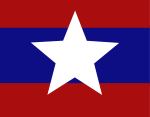

Bureau of Special Operations (ကာကွယ်ရေးဌာန စစ်ဆင်ရေး အထူးအဖွဲ့) in Myanmar Army are high-level field units equivalent to Field Army in Western terms and consist of 2 or more Regional Military Commands (RMC) and commanded by a Lieutenant-General and 6 staff officers. The units were introduced under the General Staff Office on 28 April 1978 and 1 June 1979. In early 1978, the then Chairman of BSPP General Ne Win visited the North Eastern Command Headquarters in Lashio to receive a briefing about Burmese Communist Party (BCP) insurgents and their military operations. He was accompanied by Brigadier General Tun Ye from Ministry of Defence. Brigadier General Tun Ye was the regional commander of Eastern Command for three years and before that he served in North Eastern Command areas as commander of Strategic Operation Command (SOC) and commander for Light Infantry Division for four years. As BCP military operations were spread across three Regional Military Command (RMC) areas (Northern, Eastern and North Eastern), Brigadier General Tun Ye was the most informed commander about the BCP in Myanmar Army at the time. At the briefing, General Ne Win was impressed by Brigadier General Tun Ye and realised that co-ordination among various Regional Military Commands (RMC) was necessary; thus, decided to form a bureau at the Ministry of Defence. Originally, the bureau was for "special operations", wherever they were, that needed co-ordination among various Regional Military Commands (RMC). Later, with introduction of another bureau, there was a division of command areas. The BSO-1 was to oversee the operations under the Northern Command, North Eastern Command, the Eastern Command, and the North Western Command. BSO-2 was to oversee operations under the South Eastern Command, South Western Command, Western Command and Central Command. Initially, the chief of the BSO had the rank of Brigadier General. The rank was upgraded to Major General on 23 April 1979. in 1990, it was further upgraded to Lieutenant General. Between 1995 and 2002, Chief of Staff (Army) jointly held the position of Chief of BSO. However, in early 2002, two more BSO were added to the General Staff Office; therefore there were altogether four BSOs. The fifth BSO was established in 2005 and the sixth in 2007.
Currently there are Six Bureaus of Special Operations in Myanmar order of Battle.[14]
| Bureau of Special Operations | Regional Military Commands (RMC) | Chief of Bureau of Special Operations | Notes |
|---|---|---|---|
| Bureau of Special Operations 1 | Central Command North Western Command Northern Command |
Lt.Gen. Htun Htun Naung | |
| Bureau of Special Operations 2 | North Eastern Command Eastern Command Triangle Region Command Eastern Central Command |
Lt.Gen. Yar Pye | |
| Bureau of Special Operations 3 | South Western Command Southern Command Western Command |
Lt.Gen. Aung Kyaw Zaw | |
| Bureau of Special Operations 4 | Coastal Command South Eastern Command |
Lt.Gen. Min Naung | |
| Bureau of Special Operations 5 | Yangon Command | Lt.Gen. Aung Kyaw Zaw | |
| Bureau of Special Operations 6 | Naypyidaw Command | Lt.Gen. Mya Tun Oo | Concurrently as Chief of Military Security Affairs |
Regional Military Commands (RMC)
For better command and communication, the Tatmadaw formed Regional Military Commands (တိုင်း စစ်ဌာနချုပ်) structure in 1958. Until 1961, there were only two regional commands, they were supported by 13 Infantry brigades and an infantry division. In October 1961, new regional military commands were opened and leaving only two independent infantry brigades. In June 1963, the Naypyidaw Command was temporarily formed in Yangon with the deputy commander and some staff officers drawn from Central Command. It was reorganised and renamed as Yangon Command on 1 June 1965.[14]
A total of 337 infantry and light infantry battalions organised in Tactical Operations Commands, 37 independent field artillery regiments supported by affiliated support units including armoured reconnaissance and tank battalions. RMCs are similar to corps formations in Western armies. The RMCs, commanded by Major General rank officer, are managed through a framework of Bureau of Special Operations (BSOs), which are equivalent to Field Army Group in Western terms.[14]
| Regional Military Command (RMC) | Badge | States & Divisions | Headquarters | Strength |
|---|---|---|---|---|
| Northern Command
(မြောက်ပိုင်းတိုင်းစစ်ဌာနချုပ်) |
|
Kachin State | Myitkyina | 33 Infantry Battalions |
| North Eastern Command
(အရှေ့မြောက်ပိုင်းတိုင်းစစ်ဌာနချုပ်) |
|
Northern Shan State | Lashio | 30 Infantry Battalions |
| Eastern Command
(အရှေ့ပိုင်းတိုင်းစစ်ဌာနချုပ်) |
|
Southern Shan State and Kayah State | Taunggyi | 42 Infantry Battalions including 16× Light Infantry Battalions under Regional Operation Command (ROC) Headquarters at Loikaw |
| South Eastern Command
(အရှေ့တောင်တိုင်းစစ်ဌာနချုပ်) |
Mon and Kayin (Karen) States | Mawlamyaing (Moulmein) | 36 Infantry Battalions | |
| Southern Command
(တောင်ပိုင်းတိုင်းစစ်ဌာနချုပ်) |
|
Bago and Magwe Divisions | Toungoo | 27 × Infantry Battalions |
| South Western Command
(အနောက်တောင်တိုင်းစစ်ဌာနချုပ်) |
|
Ayeyarwady Division (Irrawaddy Division) | Pathein (Bassein) | 11 × Infantry Battalions |
| Western Command
(အနောက်ပိုင်းတိုင်းစစ်ဌာနချုပ်) |
|
Rakhine (Arakan) and Chin States | Ann | 33 × Infantry Battalions |
| North Western Command
(အနောက်မြောက်တိုင်းစစ်ဌာနချုပ်) |
|
Sagaing Division | Monywa | 25 × Infantry Battalions |
| Yangon Command
(ရန်ကုန်တိုင်းစစ်ဌာနချုပ်) |
|
Yangon Division | Mayangone Township-Kone-Myint-Thar | 11 × Infantry Battalions |
| Coastal Region Command
(ကမ်းရိုးတန်းတိုင်းစစ်ဌာနချုပ်) |
|
Tanintharyi Division (Tenassarim Division) | Myeik (Mergui) | 43 Infantry Battalions including battalions under 2 MOC based at Tavoy |
| Triangle Region Command
(တြိဂံတိုင်းစစ်ဌာနချုပ်) |
Eastern Shan State | Kyaingtong (Kengtung) | 23 Infantry Battalions | |
| Central Command
(အလယ်ပိုင်းတိုင်းစစ်ဌာနချုပ်) |
Mandalay Division | Mandalay | 31 Infantry Battalions | |
| Naypyidaw Command
(နေပြည်တော်တိုင်းစစ်ဌာနချုပ်) |
Naypyidaw | Pyinmana | Formed in 2006 - ? × Infantry Battalions | |
| Eastern Central Command
(အရှေ့အလယ်ပိုင်းတိုင်းစစ်ဌာနချုပ်) |
Middle Shan State | Kho Lam | Formed in 2011 - ? × Infantry Battalions |
Commanders of Regional Military Commands
| Regional Military Command (RMC) | Established | First Commander | Current Commander | Notes |
|---|---|---|---|---|
| Eastern Command | 1961 | Brigadier General San Yu | Major General Win Min Tun | Initially in 1961, San Yu was appointed as Commander of Eastern Command but was moved to NW Command and replaced with Col. Maung Shwe then. |
| South Eastern Command | 1961 | Brigadier General Sein Win | Major General Myo Win | In 1961 when SE Command was formed, Sein Win was transferred from former Southern Command but was moved to Central Command and replaced with Thaung Kyi then. |
| Central Command | 1961 | Colonel Thaung Kyi | Major General Win Bo Shein | Original NW Command based at Mandalay was renamed Central Command in March 1990 and original Central Command was renamed Southern Command |
| North Western Command | 1961 | Brigadier General Kyaw Min | Major General Thet Pone | Southern part of original North western Command in Mandalay was renamed Central Command in March 1990 and northern part of original NW Command was renamed NW Command in 1990. |
| South Western Command | 1961 | Colonel Kyi Maung | Major General Tayzar Kyaw | Kyi Maung was sacked in 1963 and was imprisoned few times. He became Deputy Chairman of NLD in the 1990s. |
| Yangon Command | 1969 | Colonel Thura Kyaw Htin | Major General Myo Zaw Thein | Formed as Naypyidaw Command in 1963 with deputy commander and some staff officers from Central Command. Reformed and renamed Yangon Command on 1 June 1969. |
| Western Command | 1969 | Colonel Hla Tun | Major General Maung Maung Soe | |
| North Eastern Command | 1972 | Colonel Aye Ko | Major General Phone Myat | |
| Northern Command | 1947 | Brigadier Ne Win | Major General Nyi Nyi Swe | Original Northern Command was divided into Eastern Command and NW Command in 1961. Current Northern Command was formed in 1969 as a part of reorganisation and is formed northern part of previous NW Command |
| Southern Command | 1947 | Brigadier Saw Kya Doe | Major General Myat Kyaw | Original Southern Command in Mandalay was renamed Central Command in March 1990 |
| Triangle Region Command | 1996 | Brigadier General Thein Sein | Major General Aung Zaw Aye | Thein Sein later became Prime Minister and elected as President in 2011 |
| Coastal Region Command | 1996 | Brigadier General Thiha Thura Thura Sit Maung | Major General Lin Aung | |
| Naypyidaw Command | 2005 | Brigadier Wei Lwin | Major General Moe Myint Tun | |
| Eastern Central Command | 2011 | Brigadier Mya Tun Oo | Major General Than Hlaing |
Regional Operations Commands (ROC)
Regional Operations Commands (ROC)(ဒေသကွပ်ကဲမှု စစ်ဌာနချုပ်) are commanded by a Brigadier General, are similar to infantry brigades in Western Armies. Each consists of 4 Infantry battalions (Chay Hlyin Tatyin), HQ and organic support units. Commander of ROC is a position between LID/MOC commander and tactical Operation Command (TOC) commander, who commands three infantry battalions. The ROC commander holds financial, administrative and judicial authority while the MOC and LID commanders do not have judicial authority.[6][15]
| Regional Operation Command (ROC) | Headquarters | Notes |
|---|---|---|
| Loikaw Regional Operations Command | Loikaw (လွိုင်ကော်) Kayah State | |
| Laukkai Regional Operations Command | Laukkai (လောက်ကိုင်), Shan State | |
| Kalay Regional Operations Command | Kalay (ကလေး), Sagaing Division | |
| Sittwe Regional Operations Command | Sittwe (စစ်တွေ), Yakhine State | |
| Pyay Regional Operations Command | Pyay (ပြည်), Bago Division | |
| Tanaing Regional Operations Command | Tanaing (တနိုင်း), Kachin State | Formerly ROC Bhamo |
| Wanhseng Regional Operations Command | Wanhseng, Shan State | Formed in 2011 [16] |
Military Operations Commands (MOC)
Military Operations Commands (MOC) (စစ်ဆင်ရေး ကွပ်ကဲမှု ဌာနချုပ် (စကခ)), commanded by a Brigadier-General are similar to Infantry Divisions in Western Armies. Each consists of 10 Mechanised Infantry battalions equipped with BTR-3 armoured personnel carriers, Headquarters and support units including field artillery batteries. These ten battalions are organised into three Tactical Operations Commands: one Mechanised Tactical Operations Command with BTR-3 armoured personnel carriers, and two Motorized Tactical Operations Command with EQ-2102 6x6 trucks.
MOC are equivalent to Light Infantry Divisions (LID) in the Myanmar Army order of battle as both command 10 infantry battalions through three TOC's (Tactical Operations Commands). However, unlike Light Infantry Divisions, MOC are subordinate to their respective Regional Military Command (RMC) Headquarters.[15]
| Military Operation Command (MOC) | Headquarters | Notes |
|---|---|---|
| 1st Military Operations Command (MOC-1) | Kyaukme (ကျောက်မဲ), Shan State | |
| 2nd Military Operations Command (MOC-2) | Mong Nawng (မိုင်းနောင်), Shan State | |
| 3rd Military Operations Command (MOC-3) | Mogaung (မိုးကောင်း), Kachin State | |
| 4th Military Operations Command (MOC-4) | Hpugyi (ဖူးကြီး), Yangon Region | Designated Airborne Division |
| 5th Military Operations Command (MOC-5) | Taungup (တောင်ကုတ်), Rakhine State | |
| 6th Military Operations Command (MOC-6) | Pyinmana (ပျဉ်းမနား), Mandalay Region | |
| 7th Military Operations Command (MOC-7) | Hpegon (ဖယ်ခုံ), Shan State | |
| 8th Military Operations Command (MOC-8) | Dawei (ထားဝယ်), Tanintharyi Region | |
| 9th Military Operations Command (MOC-9) | Kyauktaw (ကျောက်တော်), Rakhine State | |
| 10th Military Operations Command (MOC-10) | Kyigon (ကျီကုန်း (ကလေးဝ)), Sagaing Region | |
| 12th Military Operations Command (MOC-12) | Kawkareik (ကော့ကရိတ်), Kayin State | |
| 13th Military Operations Command (MOC-13) | Bokpyin (ဘုတ်ပြင်း), Tanintharyi Region | |
| 14th Military Operations Command (MOC-14) | Mong Hsat (မိုင်းဆတ်), Shan State | |
| 15th Military Operations Command (MOC-15) | Buthidaung (ဘူးသီးတောင်), Rakhine State | |
| 16th Military Operations Command (MOC-16) | Theinni (သိန်းနီ), Shan State | |
| 17th Military Operations Command (MOC-17) | Mong Pan (မိုင်းပန်), Shan State | |
| 18th Military Operations Command (MOC-18) | Mong Hpayak (မိုင်းပေါက်), Shan State | |
| 19th Military Operations Command (MOC-19) | Ye (ရေး), Mon State | |
| 20th Military Operations Command (MOC-20) | Kawthaung (ကော့သောင်း), Tanintharyi Region | |
| 21st Military Operations Command (MOC-21) | Bhamo (ဗန်းမော်), Kachin State |
Light Infantry Divisions (LID)
Light Infantry Division (Chay Myan Tat Ma or Ta Ma Kha), commanded by a Brigadier General, each with 10 Light Infantry Battalions organised under 3 Tactical Operations Commands, commanded by a Colonel, (3 battalions each and 1 reserve), 1 Field Artillery Battalion, 1 Armour Squadron and other support units.[6][15]
These divisions were first introduced to the Myanmar Army in 1966 as rapid reaction mobile forces for strike operations. 77th Light Infantry Division was formed on 6 June 1966, followed by 88th Light Infantry Division and 99th Light Infantry Division in the two following years. 77th LID was largely responsible for the defeat of the Communist forces of the CPB (Communist Party of Burma) based in the forested hills of the central Bago Mountains in the mid-1970s. Three more LIDs were raised in the latter half of the 1970s (the 66th, 55th and 44th) with their headquarters at Pyay, Aungban and Thaton. They were followed by another two LIDs in the period prior to the 1988 military coup (the 33rd LID with headquarters at Sagaing and the 22nd LID with headquarters at Hpa-An). 11th LID was formed in December 1988 with headquarters at Inndine, Bago Division and 101st LID was formed in 1991 with its headquarters at Pakokku.[6][15]
Each LID, commanded by Brigadier General (Bo hmu gyoke) level officers, consists of 10 light infantry battalions specially trained in counter-insurgency, jungle warfare, "search and destroy" operations against ethnic insurgents and narcotics-based armies. These battalions are organised under three Tactical Operations Commands (TOC; Nee byu har). Each TOC, commanded by a Colonel (Bo hmu gyi), is made up of three or more combat battalions, with command and support elements similar to that of brigades in Western armies. One infantry battalion is held in reserve. As of 2000, all LIDs have their own organic Field Artillery units. For example, 314th Field Artillery Battery is now attached to 44th LID. Some of the LID battalions have been given Parachute and Air Borne Operations training and two of the LIDs have been converted to mechanised infantry formation with divisional artillery, armoured reconnaissance and tank battalions[6]
LIDs are considered to be a strategic asset of the Myanmar Army, and after the 1990 reorganisation and restructuring of the Tatmadaw command structure, they are now directly answerable to Chief of Staff (Army).[6][15]
| Light Infantry Division (LID) | Year formed | Headquarters | First Commander | Current Commander | Notes |
|---|---|---|---|---|---|
| 11th Light Infantry Division | 1988 | Inndine | Col. Win Myint | Formed after 1988 military coup. | |
| 22nd Light Infantry Division | 1987 | Hpa-An | Col. Tin Hla | Involved in crackdown of unarmed protestors during 8.8.88 democracy uprising | |
| 33rd Light Infantry Division | 1984 | Mandalay/later Sagaing | Col. Kyaw Ba | ||
| 44th Light Infantry Division | 1979 | Thaton | Col. Myat Thin | ||
| 55th Light Infantry Division | 1980 | Sagaing/later Kalaw | Col. Phone Myint | ||
| 66th Light Infantry Division | 1976 | Pyay | Col. Taung Zar Khaing | ||
| 77th Light Infantry Division | 1966 | Hmawbi/later Bago | Col. Tint Swe | ||
| 88th Light Infantry Division | 1967 | Magway | Col. Than Tin | ||
| 99th Light Infantry Division | 1968 | Meiktila | Col. Kyaw Htin | ||
| 101st Light Infantry Division | 1991 | Pakokku | Col. Saw Tun | Units of 101st LID were deployed during the purge of Military Intelligence faction in 2004. | |
Missile, Artillery and armoured units
Missile, Artillery and armoured units were not used in an independent role, but were deployed in support of the infantry by the Ministry of Defence as required. The Directorate of Artillery and Armour Corps was also divided into separate corps in 2001. The Directorate of Artillery and Missile Corps was also divided into separate corps in 2009. A dramatic expansion of forces under these directorates followed with the equipment procured from China, Russia, Ukraine and India.[6] [15]
Directorate of Missiles
No(1) Missile Operational Command MOC(1)
- HQ battalion
- 10 Missile Battalions:
Directorate of Artillery
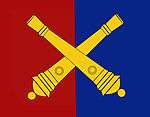
No. 1 Artillery Battalion was formed in 1952 with three artillery batteries under the Directorate of Artillery Corps. A further three artillery battalions were formed in the late 1952. This formation remained unchanged until 1988. Since 2000, the Directorate of Artillery Corps has overseen the expansion of Artillery Operations Commands(AOC) from two to 10. Tatmadaw's stated intention is to establish an organic Artillery Operations Command in each of the 12 Regional Military Command Headquarters. Each Artillery Operation Command is composed of the following:[14]
As of 2000, the Artillery wing of the Tatmadaw has about 60 battalions and 37 independent Artillery companies/batteries attached to various Regional Military Commands (RMC), Light Infantry Divisions (LID), Military Operation Command (MOC) and Regional Operation Command (ROC). For example, 314th Artillery Battery is under 44th LID, 326 Artillery Battery is attached to 5th MOC, 074 Artillery Battery is under the command of ROC (Bhamo) and 076 Artillery Battery is under North-Eastern RMC. Twenty of these Artillery battalions are grouped under 707th Artillery Operation Command (AOC) headquarters in Kyaukpadaung and 808th Artillery Operation Command (AOC) headquarters in Oaktwin, near Taungoo. The remaining 30 battalions, including 7 Anti-Aircraft artillery battalions are under the Directorate of Artillery Corps.[6] [15]
Artillery Operations Command (AOC)
- HQ battalion
- 12 Artillery battalions:
- 6 Light Field artillery battalion equipped with 105 mm, 76 mm, 75 mm howitzers, field guns and mountain guns,
- 3 Medium Field Artillery battalion equipped with 155 mm, 130 mm, 122 mm howitzers and field guns,
- 1 Multiple Rocket Launcher battalion equipped with 122 mm self-propelled and towed launchers,
- 1 Air Defence Artillery battalion with 37 mm, 57 mm Anti-Aircraft guns or SA 18 IGLAs) man portable surface-to-air missiles and
- 1 target acquisition battalion.
- support units
Light field artillery battalions consists of 3 field artillery batteries with 36 field guns or howitzers (12 guns per battery). Medium artillery battalions consists of 3 medium artillery batteries of 18 field guns or howitzers (6 guns per one battery).[14] As of 2011, all field guns of Myanmar Artillery Corps are undergoing upgrade programs including GPS Fire Control Systems.
| Artillery Operations Command (AOC) | Headquarters | Notes |
|---|---|---|
| 505th Artillery Operations Command | Myeik(မြိတ်) | |
| 707th Artillery Operations Command | Kyaukpadaung(ကျောက်ပန်းတောင်း) | |
| 606th Artillery Operations Command | Thaton(သထုံ) | |
| 808th Artillery Operations Command | Oak Twinn(အုပ်တွင်းမြို့) | |
| 909th Artillery Operations Command | Mong Khon--Kengtung | |
| 901st Artillery Operations Command | Baw Net Gyi(ဘောနက်ကြီး--ပဲခူးတိုင်း) | |
| 902nd Artillery Operations Command | Hpa-An | |
| 903rd Artillery Operations Command | Loi-Lan(လွိင်လင်) | |
| 904th Artillery Operations Command | Mohnyin(မိုးညှင်း) | |
| 905th Artillery Operations Command | Padein--Ngape |
Directorate of Armour
No. 1 Armour Company and No. 2 Armour Company were formed in July 1950 under the Directorate of Armour and Artillery Corps with Sherman tanks, Stuart light tanks, Humber Scout Cars, Ferret armoured cars and Universal Bren Carriers. These two companies were merged on 1 November 1950 to become No. 1 Armour Battalion with Headquarters in Mingalardon. On 15 May 1952 No. Tank Battalion was formed with 25 Comet tanks acquired from the United Kingdom. The Armour Corps within Myanmar Army was the most neglected one for nearly thirty years since the Tatmadaw had not procured any new tanks or armoured carriers since 1961.
Armoured divisions, known as Armoured Operations Command (AROC), under the command of Directorate of Armour Corps, were also expanded in number from one to two, each with four Armoured Combat battalions equipped with Infantry fighting vehicles and armoured personnel carriers, three tank battalions equipped with main battle tanks and three Tank battalions equipped with light tanks. [15] In mid-2003, Tamadaw acquired 139+ T-72 main battle tanks from Ukraine and signed a contract to build and equip a factory in Myanmar to produce and assemble 1,000 BTR armoured personnel carriers in 2004.[17] In 2006, the Government of India transferred an unspecified number of T-55 main battle tanks that were being phased out from active service to Tatmadaw along with 105 mm light field guns, armoured personnel carriers and indigenous HAL Light Combat Helicopters in return for Tatmadaw’s support and co-operation in flushing out Indian insurgent groups operating from its soil.[18]
Armoured Operations Command (AROC)
Armoured Operations Commands (AROC) are equivalent to Independent armoured divisions in western terms. Currently there are 5 Armoured Operations Commands under Directorate of Armoured Corps in the Tatmadaw order of battle. Tatmadaw planned to establish an AROC each in 7 Regional Military Commands.[14] Typical armoured divisions in the Myanmar Army are composed of Headquarters, Three Armored Tactical Operations Command - each with one mechanised infantry battalion equipped with 44 BMP-1 or MAV-1 Infantry Fighting Vehicles, Two Tank Battalions equipped with 44 main battle tanks each, one armoured reconnaissance battalion equipped with 32 Type-63A Amphibious Light Tanks, one field artillery battalion and a support battalion. The support battalion is composed of an engineer squadron, two logistic squadrons, and a signal company.[14]
The Myanmar Army acquired about 150 refurbished EE-9 Cascavel armoured cars from an Israeli firm in 2005.[19] Classified in the army's service as a light tank, the Cascavel is currently deployed in the eastern Shan State and triangle regions near the Thai border.
| Armoured Operations Command (ArOC) | Headquarters | Notes |
|---|---|---|
| 71st Armoured Operations Command | Pyawbwe(ပျော်ဘွယ်) | |
| 72nd Armoured Operations Command | (အုန်းတော) | |
| 73rd Armoured Operations Command | (မလွန်) | |
| 74th Armoured Operations Command | (အင်းတိုင်) | |
| 75th Armoured Operations Command | (သာဂရ) |
Bureau of Air Defence
The Air Defence Command was formed during the late 1990s but was not fully operational until late 1999. It was renamed Bureau of Air Defence in the early 2000s (decade). In early 2000, Tatmadaw established Myanmar Integrated Air Defence System (MIADS) with help from Russia, Ukraine and China. It is a tri-service bureau with units from all three branches of Myanmar Armed Forces. All Air Defence assets except Anti-Aircraft Artillery within Tatmadaw arsenal are integrated into MIADS. AAA guns are mostly unguided and deploy to use in barrage-style firing against attacking aircraft. MIADS is directly answerable to Bureau of Air Defence under Ministry of Defence.[14]
In 2010, Myanmar Air Defence Command has completed installation of optical fibre communication network throughout the country. Those network are to be used for Air defence operations between Central Command HQ from capital & several air bases, early warning radar stations & mobile anti air craft missile & artillery units. After completion of fibre optic project & radar stations, MIADS (Myanmar Integrated Air Defence System) becomes the most advance AD system in the region.
| Chief of Staff of Air Defence | Years | Notes |
|---|---|---|
| Lt. General Soe Win | 1997–2004 | Later became Prime Minister |
| Lt. General Myint Hlaing | 2004–2010 | |
| Lt. General Sein Win | 2010–2015 |
Sector Operations Commands
Under MIADS, the country was divided into six Air Defence Sectors, each controlled by a Sector Operations Center (SOC) and reporting directly to the National Air Defence Operations Centre (ADOC) in Yangon. Each SOC transmitted data back to Intercept Operations Centers (IOC), which in turn controlled surface-to-air missile batteries and fighter/interceptor squadrons at various Air Bases. Each IOC was optimised to direct either SAMs or fighter/interceptor aircraft against incoming enemy aircraft or missile. Each IOC was connected to observer and early warning area reporting posts (RP) via military owned underground fibre optic cable network. There were about 100 radar stations located at approximately 40 sites throughout the country. New Air Defence radars such as 1L117 radars, Galaxy Early Warning Radar and P series radars are installed in all radar stations.[14]
Each Sector Operation Center (SOC) is commanded by a Major General and it consists of one air defence division from Myanmar Army and one fighter-interceptor wing from Myanmar Air Force. Sometimes Air Defence Frigates from Myanmar Navy also operate under the direct command of respective SOC.
Each Air Defence division is commanded by a Brigadier General and consists of three Air Defence Tactical Operations Command (TOC) and support units. One Medium Range Surface to Air Missile Tactical Operations Command (MRSAM-TOC), with three battalions equipped with Buk M-1 or Kub missile system is deployed in an Area Defence Belt role. One Short Range Air Defence Tactical Operations Command (SHORAD-TOC), with three battalions equipped with Tor M-1 missile system is deployed in a Point Defence role for critical areas such as radar stations, fighter bases and SOC headquarters. One Electronic Reconnaissance Tactical Operations Command (EIR-TOC) with 6 to 8 radar and communication companies for early warnings and interdiction detection.
Each fighter-interceptor wing commanded by a Brigadier General and is composed of three Fighter squadrons of either MiG-29 and F-7M AirguardiInterceptors (ten aircraft per squadron) and their ground base support units.[14]
| Sector Operation Centers | Headquarters | Notes |
|---|---|---|
| Northern SOC | Myitkyina | |
| Southern SOC | Myeik | |
| Western SOC | Sittwe | |
| Eastern SOC | Tachilek | |
| South Eastern SOC | Yay | |
| Central SOC | Meiktila |
Directorate of Signal

Soon after the independence in 1948, Myanmar Signal Corps was formed with units from Burma Signals, also known as "X" Branch. It consisted HQ Burma Signals, Burma Signal Training Squadron (BSTS) and Burma Signals Squadron. HQ Burma Signals was located within War Office. BSTS based in Pyain Oo Lwin was formed with Operating Cipher Training Troop, Dispacth Rider Training Troop, Lineman Training Troop, Radio Mechanic Training Troop and Regimental Signals Training Troop. BSS, based in Mingalardon, had nince sections: Administration Troop, Maintenance Troop, Operating Troop, Cipher Troop, Lineman and Dispatch Rider Troop, NBSD Singals Troop, SBSD Signals Troop, Mobile Brigade Singals Toop and Arakan Singals Toop. The then Chief of Signal Staff Officer (CSO) was Lieutenant Colonel Saw Aung Din. BSTS and BSS were later renamed No. 1 Signal Battalion and No.1 Signal Training Battalion. In 1952, the Infantry Divisional Signals Regiment was formed and later renamed to No. 2 Signal Battalion. HQ Burma Signals was reorganised and became Directorate Signal and the director was elevated to the rank of Colonel. In 1956, No. 1 Signal Security Battalion was formed, followed by No. 3 Signal Battalion in November 1958 and No.4 Signal Battalion in October 1959.
In 1961, signal battalions were reorganised as No. 11 Signal Battalion under North Eastern Regional Military Command, No. 121 Signal Battalion under Eastern Command, No. 313 Signal Battalion under Central Command, No.414 Signal Battalion under South Western Command, and No. 515 Signal Battalion under South Eastern Command. No.1 Signal Training Battalion was renamed Burma Signal Training Depot (Baho-Setthweye-Tat).
By 1988, Directorate of Signals command one training depot, eight signal battalions, one signal security battalion, one signal store depot and two signal workshops. Signal Corps under Directorate of Signal further expanded during 1990 expansion and reorganisation of Myanmar Armed Forces. By 2000, a signal battalion is attached to each Regional Military Command and signal companies are now attached to Light Infantry Divisions and Military Operations Commands.
In 2000, Command, Control and Communication system of Myanmar Army has been substantially upgraded by setting up the military fibre optic communication network managed by Directorate of Signal throughout the country. Since 2002 all Myanmar Army Regional Military Command HQs used its own telecommunication system. Satellite communication links are also provided to forward-deployed infantry battalions. However, battle field communication systems are still poor. Infantry units are still using TRA 906 and PRM 4051 which were acquired from UK in the 1980s. Myanmar Army also uses the locally built TRA 906 Thura and Chinese XD-D6M radio sets. Frequency hopping handsets are fitted to all front line units.[20]
Between 2000 and 2005, Myanmar army bought 50 units of Brett 2050 Advanced Tech radio set from Aussie through third party from Singapore. Those units are distributed to ROCs in central & upper regions to use in counterinsurgency operations.[14][15]
Directorate of Medical Services

At the time of independence in 1948, the medical corps has two Base Military Hospitals, each with 300 beds, in Mingalardon and Pyin Oo Lwin, a Medical Store Depot in Yangon, a Dental Unit and six Camp Reception Stations located in Myitkyina, Sittwe, Taungoo, Pyinmana, Bago and Meikhtila. Between 1958 and 1962, the medical corps was restructred and all Camp Reception Stations were reorganised into Medical Battalions.
In 1989, Directorate of Medical Services has significantly expanded along with the infantry. In 2007, there are two 1,000-bed Defence Services General Hospitals (Mingalardon and Naypyitaw), two 700-bed hospitals in Pyin Oo Lwin and Aung Ban, two 500-bed military hospitals in Meikhtila and Yangon, one 500-bed Defence Services Orthopedic Hospital in Mingalardon, two 300-bed Defence Services Obstetric, Gynecological and Children hospitals (Mingalardon and Naypyitaw), three 300-bed Military Hospitals (Myitkyina, Ann and Kengtung), eighteen 100-bed Military Hospitals (Mongphyet, Baan, Indaing, Bahtoo, Myeik, Pyay, Loikaw, Namsam, Lashio, Kalay, Mongsat, Dawai, Kawthaung, Laukai, Thandaung, Magway, Sittwe, and Hommalin), fourteen field medical battalions, which are attached to various Regional Military Commands throughout the country. Each Field Medical Battalion consist of 3 Field Medical Companies with 3 Field Hospital Units and a specialist team each. Health & Disease Control Unit (HDCU) is responsible for prevention, control & eradication of diseases.
| Units | Headquarter | RMC |
|---|---|---|
| Medical Corps Centre | Hmawbi | Yangon Command |
| No.(1) Field Medical Battalion | Mandalay | Central Command |
| No.(2) Field Medical Battalion | Taunggyi | Eastern Command |
| No.(3) Field Medical Battalion | Taungoo | Southern Command |
| No.(4) Field Medical Battalion | Pathein | South Western Command |
| No.(5) Field Medical Battalion | Mawlamyaing | South Eastern Command |
| No.(6) Field Medical Battalion | Hmawbi | Yangon Command |
| No.(7) Field Medical Battalion | Monywa | North Western Command |
| No.(8) Field Medical Battalion | Sittwe | Western Command |
| No.(9) Field Medical Battalion | Mohnyin | Northern Command |
| No.(10) Field Medical Battalion | Lashio | North Eastern Command |
| No.(11) Field Medical Battalion | Bhamo | Northern Command |
| No.(12) Field Medical Battalion | Kengtung | Triangle Region Command |
| No.(13) Field Medical Battalion | Myeik | Coastal Region Command |
| No.(14) Field Medical Battalion | Taikkyi | Yangon Command |
| Health and Disease Control Unit | Mingaladon | Yangon Command |
Training
- See: Military Training in Myanmar
Defence academies and colleges
| Flags | Academies | Locations |
|---|---|---|
| | National Defence College - NDC | Naypyidaw (နေပြည်တော်) |
| | Defence Services Command and General Staff College - DSCGSC | Kalaw (ကလော) |
| | Defence Services Academy - DSA | Pyin U Lwin (ပြင်ဦးလွင်) |
| | Defence Services Technological Academy - DSTA | Pyin U Lwin (ပြင်ဦးလွင်) |
| | Defence Services Medical Academy - DSMA | Yangon (ရန်ကုန်) |
| | Military Institute of Nursing and Paramedical Science - MINP | Yangon (ရန်ကုန်) |
| Military Computer And Technological Institute - MCTI | Hopong (ဟိုပုံး) |
Training schools
| Badge | Training Schools | Locations |
|---|---|---|
| |
Officer Training School - OTS | Fort Ba Htoo |
| |
Basic Army Combat Training School | Fort Ba Htoo |
| |
1st Army Combat Forces School | Fort Ba Htoo |
| |
2nd Army Combat Forces School | Fort Bayinnaung |
| |
Artillery Training School | Mone Tai |
| Armour Training School | Maing Maw | |
| Electronic Warfare School | Pyin U Lwin | |
| Engineer School | Pyin U Lwin | |
| Information Warfare School | Yangon | |
| |
Air, Land and Paratroops Training School | Hmawbi |
| Special Forces School | Fort Ye Mon |
Ranks and insignia
The various rank of the Myanmar Army are listed below in descending order:[14]
Commissioned officers
Note: Senior General (OF-10) is the highest rank in Myanmar Armed Forces and Vice Senior General/Admiral in the Army, Navy, Air Force, Bureau of Air Defence, Chief of Staff, Adjutant General, Quartermaster General and Bureau of Special Operations.
| Myanmar title | ဗိုလ်ချုပ်မှူးကြီး | ဒုတိယ ဗိုလ်ချုပ်မှူးကြီး | ဗိုလ်ချုပ်ကြီး | ဒုတိယ ဗိုလ်ချုပ်ကြီး | ဗိုလ်ချုပ် | ဗိုလ်မှူးချုပ် | |
|---|---|---|---|---|---|---|---|
| MLC TS | Bo Gyoke Hmu Gyi | Du Bo Gyoke Hmu Gyi | Bo Gyoke Kyee | Du Bo Gyoke Kyee | Bo Gyoke | Bo Hmu Gyoke | |
| Abbreviation | ဗခမက | ဒုဗခမက | ဗခက | ဒုဗခက | ဗခ | ဗမခ | |
| Western Version | Senior General | Vice Senior General | General | Lieutenant General | Major General | Brigadier General | |
| UK equivalent | Field Marshal | nil | General | Lieutenant General | Major General | Brigadier | |
| NATO Code | OF-10 | OF-9 | OF-8 | OF-7 | OF-6 | ||
| Myanmar title | ဗိုလ်မှူးကြီး | ဒုတိယ ဗိုလ်မှူးကြီး | ဗိုလ်မှူး | ဗိုလ်ကြီး | ဗိုလ် | ဒုတိယဗိုလ် |
|---|---|---|---|---|---|---|
| MLC TS | Bo Hmu Gyi | Du Bo Hmu Gyi | Bo Hmu | Bo Gyi | Bo | Du Bo |
| Abbreviation | ဗမက | ဒုဗမက | ဗမ | ဗက | ဗ | ဒုဗ |
| Western Version | Colonel | Lieutenant Colonel | Major | Captain | Lieutenant | Second Lieutenant |
| UK equivalent | Colonel | Lieutenant Colonel | Major | Captain | Lieutenant | Second Lieutenant |
| NATO Code | OF-5 | OF-4 | OF-3 | OF-2 | OF-1 | |
Non-Commissioned Officers (NCOs)
Non-commissioned officers are referred to as Saya(ဆရာ), meaning Teacher, by both enlisted men and officers. For example, Warrant Officers, Regimental Sergeant Majors and Master Sergeant are referred to as Sayagyi (ဆရာကြီး), literally meaning "Old Teacher", Sergeant are referred to as Saya and Corporal/Lance Corporal as Sayalay(ဆရာလေး). These unofficial ranks are used throughout the daily life of all branches. Non-Commissioned Officers (NCO) within the Myanmar Armed Forces are usually seasoned veteran soldiers. Thus both Officers and enlisted men refer to them as "teacher" out of respect.
| Myanmar title | အရာခံဗိုလ် | ဒုအရာခံဗိုလ် | တပ်ခွဲတပ်ကြပ်ကြီး | တပ်ကြပ်ကြီး | တပ်ကြပ် | ဒုတပ်ကြပ် | တပ်သား | တပ်သားသစ် |
|---|---|---|---|---|---|---|---|---|
| MLC TS | Ayagan Bo | Du-Ayagan Bo | Tatkhwè Tatkyatkyi | Tatkyatkyi | Tatkyat | Du-Tatkyat | Tet Thar | Tet Thar Teet |
| Western Version | Warrant Officer | Regimental Sergeant Major | Staff Sergeant | Sergeant | Corporal | Lance Corporal | Private | Private Recruit |
| UK equivalent | Warrant Officer Class One | Warrant Officer Class Two | Staff Sergeant | Sergeant | Corporal | Lance Corporal | Private | Private Recruit |
Order of battle
- 14 x Regional Military Commands (RMC) organised in 6 Bureau of Special Operations (BSO)
- 6 x Regional Operations Commands (ROC)
- 20 × Military Operations Commands (MOC) including 1 x Airborne Infantry Division
- 10 x Light Infantry Divisions (LID)
- 10 x Armoured Operation Commands (AOC) (Each with 6 Tank Battalions and 4 Armoured Infantry Battalions (IFVs/APCs).)
- 10 x Artillery Operation Commands (AOC) (with of 113 Field Artillery Battalions)
- 6 x Anti-Aircraft Artillery/Air Defence Division (Each with 3 × Medium Range SAM Battalions, 3 × Short Range SAM Battalions, 3 × AAA/AD Battalion)
- 40+ Military Affair Security Companies (MAS Units replaces former Military Intelligence Units after the disbandment of the Directorate of Defence Service Intelligence (DDSI))
- 45 Advanced Signal Battalions
- 54 Field Engineer Battalions
- 4 Armoured Engineer Battalions
- 14 Medical Battalions
Equipment
Armoured vehicles
| Photo | Model | Type | Quantity | Origin | Notes | |
|---|---|---|---|---|---|---|
| Tank | ||||||
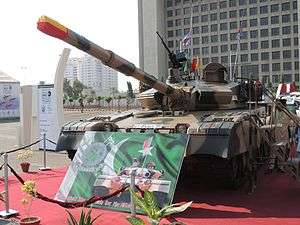 | MBT-2000 | Main battle tank | 148[21] | 3 regiments | ||
 | T-72S | Main battle tank | 139 [22][23][24] | | Purchased from Ukraine.3 regiments are equipped with 48 tanks each.[25] | |
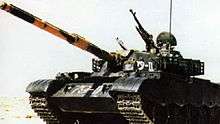 | Type 69-II[26] | Main battle tank | 80[27] | | Used mainly for training and as reserves. | |
 | Type 59D | Main Battle Tank | 160 [28] | |||
 | T-55 | Medium tank | 10[22] | | Acquired from India. | |
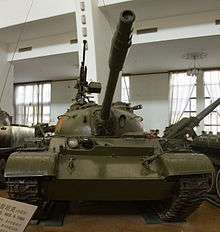 | Type 62[27] | Light tank | 105[27] | | ||
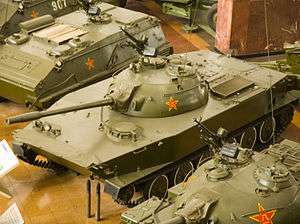 | Type 63[27] | Light tank | 50[27] | | ||
| Armoured Vehicle | ||||||
 | BTR-3U[29][30] | Infantry fighting vehicle, Armoured personnel carrier | 522 (1,000 on ordered) | | Purchased as kits to be assembled locally until 2013 to circumvent embargo. | |
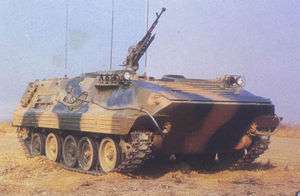 | Type 90 AFV | Armoured personnel carrier | 55[17] | | ||
 | Type 85 | Armoured personnel carrier | 250[31] | | Type 85 AFV#Operators | |
| MT-LB | Armoured personnel carrier | 98[32] | delivered in 2007. 3 regiments are equipped with 44 MT-LB MSh each. | |||
 | Ferret | Armoured car | 45[33] | | ||
| Panhard AML | Armoured car | 50[34] | | Modernized by Israel | ||
 | Humber Pig | Armoured personnel carrier | 40[22] | | ||
| image | BAAC or MAV-1[35] | Armoured personnel carrier | 44[36] | | 1983-1991 locally made 12.7mm machine gun | |
| Panhard M3 [37] | Armoured personnel carrier | 10[22] | | Modernized by Israel | ||
 | WZ551 | Armoured personnel carrier | 144 [38] | PTL02 tank destroyer variant. | ||
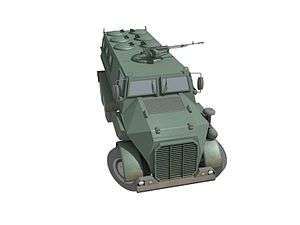 | MPV | Mine-Resistant Ambush Protected | 10[22] | | Mine protected armoured personnel carrier. | |
| EE-9 Cascavel | armoured reconnaissance vehicle | 150[19] | | Sold By Israel, based in eastern Shan State and triangle regions near Thai-Myanmar border.[39] | ||
 | Type 84 [40] | Armoured vehicle-launched bridge | 16 | | Seen on Local MRTV | |
| Type 653[37] | Armoured recovery vehicle | 18 | | |||
Artillery
| Photo | Model | Origin | Quantity | Notes | ||
|---|---|---|---|---|---|---|
| Self-propelled artillery | ||||||
| Image | Norinco SH1 | | 78 | 155 mm self-propelled howitzer | ||
 | Nora B-52[42] | |
30 | 155 mm self-propelled howitzer | ||
| BM-21/BA-84/Type-90 | |
84[23] | Used during Battle of Border Post 9631with Thais, Seen on Local TV | |||
| Towed artillery | ||||||
.jpg) | D-30M | |
560[31] | 122 mm howitzer | ||
.jpg) | Type 59-1 | |
16[31] | 130 mm field gun | ||
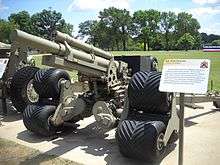 | Various 105 mm guns | |
100+[31] | Types: M56 and others. | ||
| Type 63 | |
30[31] | 107 mm multiple rocket launcher (towed) | |||
 | M48 | 212[43] | 76 mm mountain gun | |||
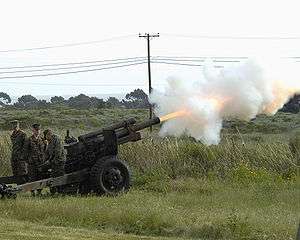 | M101 howitzer | 242 | 105 mm M2A1 | |||
| Ordnance QF 25 pounder | 50[23] | 87.6 mm Field gun/Howitzer | ||||
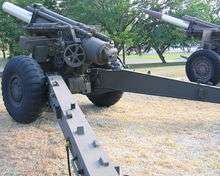 | KH-179 [23] | 100+ | 155 mm Howitzer | |||
| Soltam M-845P | 72[23] | 155 mm 45 calibre towed gun howitzer | ||||
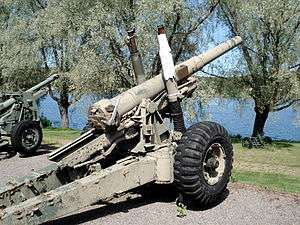 | BL 5.5-inch Medium Gun | 230?[23] | 140 mm Towed | |||
Air Defence
| Photo | Model | Origin | Quantity | Notes | ||
|---|---|---|---|---|---|---|
| Missile systems | ||||||
 | BAe Dynamics Bloodhound Mk.II[6][44][45] | |
60 | Supplied by Singapore | ||
| SA-2 | 48[23] | surface-to-air missile | ||||
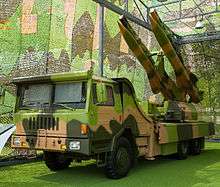 | KS-1A | 4 Battalions[23] | Medium-range surface-to-air missile | |||
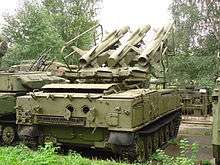 | SA-6 | 24[23] | medium-range surface-to-air missile system | |||
| | Hwasong-6 | |
11[46] | Range:700 km | ||
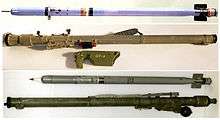 | 9K38 Igla (SA-18 Grouse)&(SA-16) | |
100 x SA16 [31] 400 x SA18[23] |
Very short-range portable surface-to-air missile system (MANPADS) | ||
 | SA-19 | 24[23] | Tracked SAM system | |||
 | Pechora-2M | |
24 [23][47] | surface-to-air missile system | ||
| Gun systems | ||||||
 | Type-74 | |
24[31] | 37 mm | ||
 | Anti-Aircraft Guns Various model | Various | 200[23] | 37mm/40mm/57mm Anti-Aircraft Guns | ||
.jpg) | KPV heavy machine gun | |
||||
Anti Tank
| Photo | Model | Origin | Quantity | Notes | ||
|---|---|---|---|---|---|---|
| Systems | ||||||
 | M40 recoilless rifle | 200[23][48] | Anti Tank Weapon | |||
 | Carl Gustav recoilless rifle | 1000[23] | Anti Tank | |||
Weapons
| Name | Type | Versions | Ammunition | Used by | Picture | |
|---|---|---|---|---|---|---|
| Small arms | ||||||
| Browning Hi-Power[49] | 9×19mm Parabellum | |||||
| Heckler & Koch G3[49] | 7.62×51mm NATO |  | ||||
| MP5 submachine gun[49] | Multiple (9×19mm Parabellum, 10mm Auto MP5/10, or .40 S&W M5/40) | 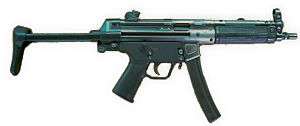 | ||||
| EMERK-3 | 5.56×45mm NATO | Image | ||||
| Heckler & Koch HK33[49] | 5.56×45mm NATO | .jpg) | ||||
| SIG Sauer P226 (MA-6)[49] | 9×19mm Parabellum |  | ||||
| FN FAL[49] | 7.62×51mm NATO | | ||||
| Type 81 assault rifle[49] | 7.62×39mm | | ||||
| SPAS 12[49] | 12 Gauge |  | ||||
| Barrett M82[49] | .416 Barrett |  | ||||
| M249 machine gun[49] | 5.56×45mm NATO |  | ||||
| Rheinmetall MG3[49] | 7.62×51mm NATO | 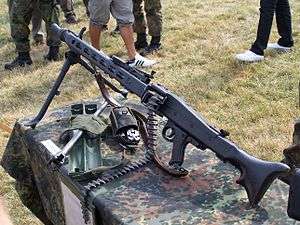 | ||||
| M2 Browning machine gun[49] | .50 BMG | 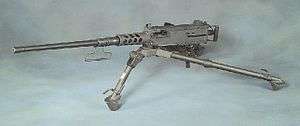 | ||||
See also
- Aung San
- Tatmadaw
- Myanmar Navy
- Myanmar Air Force
- Military Intelligence of Myanmar
- Myanmar Police Force
References
- ↑ International Institute for Strategic Studies, pp. 265-266 (3 February 2014). The Military Balance 2014. London: Routledge. ISBN 9781857437225.
- ↑ The Asian Conventional Military Balance 2006 (PDF), Center for Strategic and International Studies, 26 June 2006, p. 4
- ↑ "Myanmar allocates 1/4 of new budget to military". Associated Press. 1 March 2011.
- 1 2 Defence Services Historical Museum and Research Institute (DSHMRI) Archives
- ↑ Working Papers - Strategic and Defence Studies Centre, Australian National University
- 1 2 3 4 5 6 7 8 9 10 11 Selth, Andrew (2002): Burma's Armed Forces: Power Without Glory, Eastbridge. ISBN 1-891936-13-1
- ↑ Far Eastern Economic Review, 20 May 1981
- ↑ FEER, 7 July 1983
- ↑ Bertil Lintner, Land of Jade
- ↑ Asiaweek 21 February 1992
- ↑ The Defence of Thailand (Thai Government issue), p.15, April 1995
- ↑ "Myanmar's losing military strategy". Asia Times Online. 7 October 2006. Retrieved 28 July 2010.
- ↑ WP 342. Australian National University
- 1 2 3 4 5 6 7 8 9 10 11 12 13 14 15 Defence Services Historical Museum and Research Institute
- 1 2 3 4 5 6 7 8 9 10 11 Myoe, Maung Aung: Building the tatmadaw - Myanmar Armed Forces Since 1948, Institute of SouthEast Asian Studies. ISBN 978-981-230-848-1
- ↑ http://www.irrawaddy.org/article.php?art_id=20435
- 1 2 http://www.irrawaddy.org/article.php?art_id=954
- ↑ "Defense19". Retrieved 29 November 2014.
- 1 2 "Why Russia". Archived from the original on 5 December 2014. Retrieved 12 March 2015.
- ↑ "Burmanet » Jane's Intelligence Review: Radio active – Desmond Ball and Samuel Blythe". Retrieved 29 November 2014.
- ↑ http://www.strategypage.com/dls/articles/Chinese-Tanks-For-Everyone-5-6-2012.asp
- 1 2 3 4 5 "SIPRI Trade Register". Stockholm International Peace Research Institute.
- 1 2 3 4 5 6 7 8 9 10 11 12 13 14 15 "Myanmar". Retrieved 29 November 2014.
- ↑ David Fullbrook (18 December 2006). "Burma's Generals on a Buying Spree". Asia Sentinel. Retrieved 20 March 2011.
- ↑ http://www.altsean.org/Research/SPDC%20Whos%20Who/Armssuppliers.htm#Russia
- ↑ Selth, Andrew: "The Burmese Army". In: Jane's Intelligence Review, 1 November 1995. Retrieved 30 January 2009.
- 1 2 3 4 5 https://www.rand.org/content/dam/rand/pubs/monograph_reports/MR1119/MR1119.appa.pdf
- ↑ Mg Han. "Myanmar Defence Weapons". Retrieved 29 November 2014.
- ↑ Amnesty International, EU Office. EU arms embargoes fail to prevent German engines being incorporated into military vehicles available in Burma/Myanmar, China and Croatia. Seen 4 January 2009.
- ↑ Ashton, William: The Kiev Connection. In: The Irrawaddy, 12, 4 (2004). Seen 4 January 2009.
- 1 2 3 4 5 6 7 "Trade Registers". Retrieved 29 November 2014.
- ↑ http://www.sipri.org/contents/armstrad/at_data.html
- ↑ "Asean Defence Yearbook 2009". Retrieved 29 November 2014.
- ↑ Wheeled Armored Fighting Vehicles
- ↑ https://www.facebook.com/htnaw84/info
- ↑ Building the Tatmadaw: Myanmar Armed Forces Since 1948 By Maung Aung Myoe, p107-108
- 1 2 MM. "Myanmar Defence Weapons". Retrieved 29 November 2014.
- ↑ MM. "Myanmar Defence Weapons". Retrieved 29 November 2014.
- ↑ Mg Han. "Myanmar Defence Weapons". Retrieved 29 November 2014.
- ↑ MM. "Myanmar Defence Weapons". Retrieved 29 November 2014.
- ↑ BIRN (2010)
- ↑ BIRN (2007):Serbia's Arms Exports to Myanmar (Burma) "Legal", Ocnus.net. Seen 4 January 2009.
- ↑ MM. "Myanmar Defence Weapons". Retrieved 29 November 2014.
- ↑ "Selth, Andrew (2000): Burma's Order of Battle: An Interim Assessment. ISBN 0-7315-2778-X". Retrieved 29 November 2014.
- ↑ IISS The Military Balance 2007
- ↑ Hwasong-6#Operators
- ↑ "Unique surface-to-air missile baffles foreign military diplomats in Egypt". Retrieved 29 November 2014.
- ↑ Mg Han. "Myanmar Defence Weapons". Retrieved 29 November 2014.
- 1 2 3 4 5 6 7 8 9 10 11 12 Jones, Richard D. Jane's Infantry Weapons 2009/2010. Jane's Information Group; 35th edition (27 January 2009). ISBN 978-0-7106-2869-5.
- http://www.strategypage.com/htmw/htada/articles/20081229.aspx?comments=Y
- http://www.enotes.com/topic/Myanmar_Armed_Forces
Further reading
- Samuel Blythe, 'Army conditions leave Myanmar under strength,' Jane's Defence Weekly, Vol. 43, Issue 14, 5 April 2006, 12.
External links
- Role of officers in Burmese Army (Part 1) Bo Htet Min, Mizzima, 23 January 2010
.svg.png)